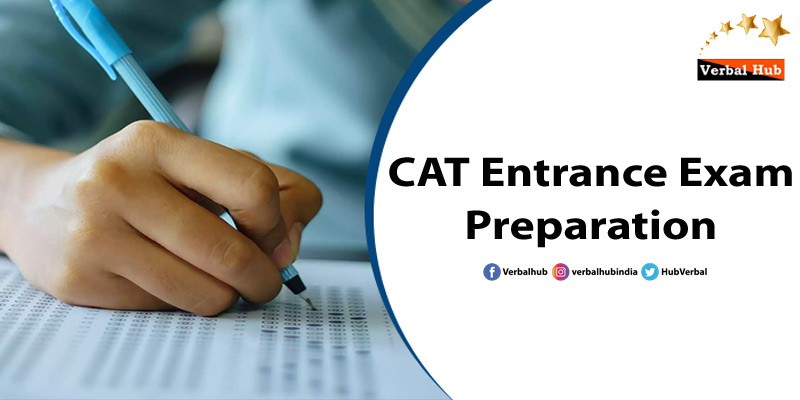

Index
How to Prepare for CAT 2024 in 6 Months
If you are preparing for CAT exam or CAT 2024, you must hunt the answer to the how to prepare for CAT 2024 in 6 months or How can we prepare for CAT exam. Although, the fact is How to Prepare for the CAT exam 2024 can be a challenging endeavor, especially for beginners, though, with a strategic approach, it is possible to efficiently prepare for CAT 2024 within six months.
This blog will focus on giving the idea how to study for CAT, how to prepare for DILR for CAT, how to prepare for VARC in CAT, How to prepare for QA in CAT, Test Taking strategy and final tips and tricks.
General Tips: CAT 2024 preparation
The first step for CAT 2024 preparation is to understand the CAT exam pattern and CAT syllabus thoroughly. Start by creating a realistic and comprehensive study plan that covers all sections of the CAT exam syllabus, dedicating ample time to quantitative aptitude, verbal ability, and logical reasoning. To enhance CAT preparation 2024, utilize a variety of resources such as CAT preparation books, online courses, and practice tests. Consistent practice and regular self-assessment are crucial for improvement. Joining a study group or enrolling in a CAT coaching class is always advantageous and motivation. Remember, the key to success in CAT 2024 preparation lies in a disciplined approach, effective time management, and persistent effort. With these strategies, you can confidently aim for a high score in the CAT 2024 exam.
What is CAT Exam
Before you start working on how to prepare for CAT exam 2024, let us know what is CAT Exam. CAT stands for the Common Admission Test, that takes place in November, that is one of most challenging exam in India, and that is attempted for admission to the postgraduate management programs (MBA/PGDM) of the Indian Institutes of Management (IIMs) and various other business schools. Bullet points of CAT Exam. Key details about the CAT exam:
| ⮚Exam Body: | The Indian Institutes of Management (IIMs). | |
| ⮚Eligibility: | Either a bachelor's degree with at least 50% marks or an equivalent CGPA (45% for SC, ST, and PWD categories). | |
| ⮚Note: | Final year students of a bachelor's degree may apply. | |
| ⮚Exam Pattern: | Verbal Ability and Reading Comprehension (VARC), Data Interpretation and Logical Reasoning (DILR), and Quantitative Ability (QA) | |
| ⮚Duration: | 120 minutes, with 40 minutes each section. | |
| ⮚The exam usually features both multiple-choice questions (MCQs) and non-multiple-choice questions (TITA - Type In The Answer). | ||
Scoring and Percentiles:
- ⯀ Each correct answer carries three marks.
- ⯀ For each incorrect answer in the MCQs, one mark is deducted as a penalty.
- ⯀ No negative marking for non-MCQs.
- ⯀ The scores are scaled and converted into percentiles to rank candidates.
- ⯀ Application Process: The application process includes completing an online form, submitting the required documents, and paying the application fee.
- ⯀ The application fee differs based on the applicant's category (general, SC/ST, PWD).
Selection Process:
Based on the CAT score, candidates are shortlisted for the next rounds, which generally consist of a Written Ability Test (WAT), Group Discussion (GD), and Personal Interview (PI).
- ⋆ The final selection is determined by considering the CAT score, academic achievements, work experience, and performance in the WAT, GD, and PI stages.
- ⋆ Importance: CAT is one of the most prestigious and highly regarded management entrance examinations in India.
- ⋆ High performance in the CAT exam can lead to admission to top management institutes, providing excellent career opportunities.
- ⋆ The CAT exam takes place in November and result is announced in December-January.
CAT Questions and Topic-Wise Questions
The number of questions of CAT exam with topics is essential before jumping how can we prepare for CAT or how to start preparing for CAT 2024. The exact number of questions from each topic in the CAT exam can vary from year to year as the exam pattern is not fixed. However, the CAT exam has its structure and below is a general breakdown based on recent years:
Verbal Ability and Reading Comprehension (VARC)Total Questions: 24
Reading Comprehension (RC): Approximately 24 questions| ⮚There are around 4 passages with 4 questions each. |
Verbal Ability (VA): Approximately 8 questions
| ⮚Para Jumbles: | 2-3 questions |
| ⮚Para Summary: | 2-3 questions |
| ⮚Odd Sentence Out: | 2-3 questions |
Data Interpretation and Logical Reasoning (DILR)
Total Questions: 20
The section is typically divided into 5 sets, with each set containing 4 questions.
| ⮚Data Interpretation (DI): | 2-3 sets (approximately 12 questions) |
| ⮚Logical Reasoning (LR): | 2-3 sets (approximately 12 questions) |
Total Questions: 22
The questions in this section are distributed across various topics, with no fixed number for each topic. However, a rough estimate based on recent trends is as follows:
| ⮚Arithmetic: | 6-8 questions |
| ⮚Algebra: | 6-8 questions |
| ⮚Geometry and Mensuration: | 4-6 questions |
| ⮚Number System: | 2-4 questions |
| ⮚Modern Mathematics: | 2-4 questions |
This distribution is indicative and varies each year based on the exam setters' discretion. The total number of questions in the CAT exam is usually 66, with each section having a time limit of 40 minutes. The was the first step how to prepare for cat for beginners.
List of CAT Exam Syllabus
Preparation for the CAT exam requires a strategic approach, focusing on practicing a wide range of questions across all topics to handle any variations in the exam pattern. Here are the major topics of CAT exam syllabus included in each section such as VARC, QA, and DILR:
Verbal Ability and Reading Comprehension (VARC)
Reading Comprehension:| ⯀ Passages on various subjects such as economics, history, science, literature, etc. | ||
| ⯀ Questions related to understanding, interpreting, and analyzing the passage. |
Verbal Ability:
| ⯀ Sentence Correction | ||
| ⯀ Sentence Completion | ||
| ⯀ Para Jumbles (Rearranging sentences to form a coherent paragraph) | ||
| ⯀ Para Summary (Summarizing a given paragraph) | ||
| ⯀ Odd Sentence Out (Identifying the sentence that does not fit into the context of a given paragraph) |
Data Interpretation and Logical Reasoning (DILR)
| • Data Interpretation: | ||
| • Tables | ||
| • Bar Graphs | ||
| • Line Charts | ||
| • Pie Charts | ||
| • Caselets (short cases with data) | ||
| • Data Sufficiency |
Logical Reasoning:
| • Seating Arrangement (Linear, Circular, Square, etc.) | ||
| • Puzzles | ||
| • Blood Relations | ||
| • Syllogisms | ||
| • Venn Diagrams | ||
| • Statements and Assumptions | ||
| • Statements and Conclusions | ||
| • Calendars and Clocks | ||
| • Binary Logic |
Quantitative Ability (QA) Arithmetic:
| o Percentages | ||
| o Profit and Loss | ||
| o Simple and Compound Interest | ||
| o Ratio and Proportion | ||
| o Time, Speed, and Distance | ||
| o Time and Work | ||
| o Mixtures and Alligations |
Algebra:
| o Linear Equations | ||
| o Quadratic Equations | ||
| o Inequalities | ||
| o Functions | ||
| o Progressions (Arithmetic Progression, Geometric Progression) | ||
| o Logarithms |
Geometry and Mensuration:
| o Lines and Angles | ||
| o Triangles (Properties, Congruence, and Similarity) | ||
| o Circles | ||
| o Polygons | ||
| o Coordinate Geometry | ||
| o Mensuration (Areas, Volumes, Surface Areas) |
Number System:
| o Divisibility | ||
| o Factors and Multiples | ||
| o HCF and LCM | ||
| o Remainders | ||
| o Base Systems | ||
| o Properties of Numbers (Prime Numbers, Even and Odd Numbers) |
Modern Mathematics:
| o Permutations and Combinations | ||
| o Probability | ||
| o Set Theory | ||
| o Trigonometry (Basic concepts) |
Note: Understanding the CAT Exam syllabus and its topics is crucial for devising an effective study plan. Even, it is crucial to go through CAT syllabus to work on how to study for CAT. To stand out in CAT 2024, you must familiarize themselves with the syllabus, focusing on key areas such as quantitative aptitude, verbal ability, and logical reasoning. To prepare for CAT, it's essential to follow a structured approach, including regular practice, mock tests, and analysis of performance. Embracing a consistent study routine and utilizing reliable resources enhances your CAT preparation 2024 journey. By staying dedicated and methodical, you tackle the challenges of the CAT exam and achieve your desired results.
How to Start DILR Preparation for CAT
Starting your DILR (Data Interpretation and Logical Reasoning) preparation for CAT is a task, but with result-centric strategy, it's entirely manageable. To study DILR for CAT effectively, begin by familiarizing yourself with the various question types and formats found in past exams. To prepare for DILR CAT, focus on basic concept, and then solve difficult and hard questions. Consistent practice is key to cracking DILR in CAT, so incorporate timed practice sessions to simulate exam conditions. To improve your DILR for CAT, analyze your mistakes thoroughly and learn from them, refining your approach with each practice session. However, with a strategic approach and dedicated practice, you can master this section and significantly boost your overall CAT score. In further discussion, this blog will explore various aspects of how to start DILR preparation for CAT, how to study effectively, and ultimately, how to crack this section with confidence.
I. Understanding the DILR SectionBefore diving into how to study DILR for CAT, it's essential to understand what the DILR section entails. This section tests your ability to interpret data and solve logical puzzles, which requires a mix of analytical skills, logical reasoning, and quick thinking. DILR carries two sections:
- ✓Data Interpretation (DI): This part involves interpreting data from charts, graphs, tables, and other data sets. The questions test your ability to analyze and draw conclusions from the given data.
- ✓Logical Reasoning (LR): This part includes puzzles, seating arrangements, blood relations, and other logical problems that require a structured and logical approach to solve.
II. How to Start DILR Preparation for CAT
Starting DILR preparation for CAT section is a task, but with a clear plan, you can ease into it effectively. Some steps to work on how to start DILR preparation for CAT:
- ⮚Know Current Level: Begin by taking a few mock tests or solving previous years' CAT papers to gauge your current proficiency in DILR.
- ⮚Syllabus and Pattern: understand types of question of CAT DILR and know the syllabus and question patterns.
- ⮚Gather Study Materials: Gather CAT DILR study materials, which combines books, practice questions, sectional tests and practice tests.
III. How to Study DILR for CAT
Disciplined study is going to resolve your concern about how to study DILR for CAT. Here are some strategies to enhance your study routine:
- ⯀ Conceptual Clarity: Start working on the foundation of basic concepts. Understand the fundamental principles behind data interpretation and logical reasoning problems.
- ⯀ Practice Regularly: Consistent practice is crucial for DILR. Solve a variety of problems daily to get comfortable with different question types and difficulty levels.
- ⯀ Time Management: Practice solving questions under a timer. This will give you a feeling of a real exam.
- ⯀ Analyze: After solving practice questions or mock tests, spend time analyzing your mistakes. Find out your error and weaker section and then fix your approach to avoid similar errors in the future in the CAT DILR section.
IV. How to Prepare for DILR CAT
To prepare effectively for the DILR section, you need a well-structured plan to work on how to prepare for DILR CAT. Here's a step-by-step guide:
- • Daily Practice: Dedicate at least an hour daily to DILR practice. Begin with easy question, then move to medium level of DILR CAT questions and then hard level of CAT DILR practice questions:
- • Mock Tests: Take full-length mock tests regularly. This not only helps in practice but also improve time management skills.
- • Review: First review your performance and then revise concept religiously until you gain confidence in the DILR concepts.
V. How to Practice DILR for CAT
Here are some tips to keep in mind while working on how to practice DILR for CAT:
- o Varied Question Sets: Practice a diverse range of question sets to cover all possible types of questions that can appear in the exam.
- o Weak Areas: Pinpoint your weaker section and devote some time to enhance them. Practice more questions from these topics to build confidence.
- o Online Resources: Use the available CAT DILR resources such as practice questions, mock exams, and instructional video tutorials.
VI. How to Crack DILR in CAT Exam
Cracking the DILR section requires a blend of strategy, practice, and confidence. Here are clues to help you to work on how to crack DILR in CAT Exam
- o Approach: Develop a strategy for attempting the DILR section. Choose the sequence in which you will tackle the questions according to your strengths.
- o Speed and Accuracy: Concentrate on improving both your speed and precision. Practice mental calculations and develop shortcuts for quicker problem-solving.
Improvement comes with persistent effort and refinement of techniques. Here’s how you can continuously deal with how to improve DILR for CAT exam skills:
- ∘ Feedback: Seek regular feedback on your performance from teachers and friends. Their pinpoint will help you improve DILR for CAT.
- ∘ Learning: Adapt your learning methods based on your progress. If a particular strategy isn’t working, search new way of prep.
List of Books for CAT DILR Prep
These are some books for how to prepare for CAT DILR and how to prepare DILR for CAT.
- 1. "How to Prepare for Data Interpretation & Logical Reasoning for CAT" by Arun Sharma: This book provides comprehensive coverage of both data interpretation and logical reasoning topics, along with numerous practice questions and solutions.
- 2. "Logical Reasoning and Data Interpretation for the CAT" by Nishit K. Sinha: Known for its clear explanations and a wide range of practice problems, this book is a favorite among CAT aspirants.
- 3. "CAT Data Interpretation & Logical Reasoning" by Gautam Puri: This book offers detailed strategies and practice sets to help students master DILR questions.
- 4. "A Modern Approach to Logical Reasoning" by R.S. Aggarwal: A popular choice for logical reasoning preparation, this book covers various types of reasoning problems encountered in competitive exams.
- 5. "Data Interpretation & Data Sufficiency" by Ananta Ashisha: Focuses specifically on data interpretation and sufficiency, providing targeted practice for these types of questions.
- 6. "The Pearson Guide to Logical Reasoning and Data Interpretation" by Nishit K. Sinha: Another excellent resource from Nishit K. Sinha, offering a comprehensive guide to both LR and DI sections.
- 7. "Trishna’s Verbal Ability and Logical Reasoning for the CAT and Other MBA Examinations" by TIME: A comprehensive guide that covers both verbal ability and logical reasoning, useful for overall CAT preparation.
- 8. "Data Interpretation & Logical Reasoning for CAT" by Gajendra Kumar: Provides a good collection of practice questions and strategies for tackling DILR sections.
- 9. "Face To Face CAT Common Admission Test" by Arihant: A compilation of previous years' CAT papers, which includes sections on data interpretation and logical reasoning, helping students get familiar with the exam pattern.
Note: Using these books, along with consistent practice and analysis, will help you strengthen your skills in the DILR section for the CAT exam. How to prepare for DILR in CAT begins with a clear understanding of the basics, practicing regularly, and continuously refining your strategies. Remember, a positive attitude, practice, and consistency are key to solidify how to prepare for DILR.
How to Prepare for VARC in CAT for CAT Exam
The Verbal Ability and Reading Comprehension (VARC) section of the Common Admission Test (CAT) is crucial for achieving a high overall score. Excelling in this section requires both a solid plan and strong discipline. This section of how to prepare for VARC in CAT for CAT exam will explore prep strategy, practice section, step by step learning and list of books to follow. Additionally, how to prepare for CAT VARC, how to prepare for VARC in CAT, and how to study VARC for CAT will prime highlight. Here we go:
I. Know the VARC Section
Before diving into the preparation strategies, update yourself with the structure of the VARC section. This section tests your proficiency in English language skills which consist of basic grammar, some general vocabulary knowledge, and comprehension ability. This section is combination of two parts:
Reading Comprehension (RC): This part involves reading passages and answering questions based on them. The questions test your ability to understand and interpret the given text.
Verbal Ability (VA): This part includes questions on grammar, sentence correction, para-jumbles, and summary-based questions. It tests your command over the language and logical arrangement of sentences.
II. How to Start VARC Preparation for CATStarting your preparation for the VARC section requires additional effort. However, with a clear plan, you can ease into it effectively. Here are some steps for how to start VARC preparation for CAT:
- o Know the Level: Begin by taking a few mock tests or solving previous years’ CAT papers to gauge your current proficiency in VARC.
- o Grasp the Syllabus and Format: Acquaint yourself with the types of questions typically found in the VARC section. By understanding the syllabus and question patterns, you can tailor your preparation to concentrate on the most pertinent topics.
- o Collect Resources: Gather trustworthy study resources, for example, CAT VARC books, practice questions, sectional tests and full test.
III. How to Prepare for VARC for CAT
Effective study techniques always create difference in VARC CAT prep. The strategies for how to prepare for VARC for CAT are:
- ⯀ Develop Reading Habits: Cultivate a routine of daily reading. Engage with diverse materials like newspapers, magazines, novels, and academic journals to enhance your reading speed, comprehension, and vocabulary.
- ⯀ Practice Reading Comprehension (RC) Passages: Regularly work on RC passages, focusing on identifying the main idea, tone, and structure. Practice various question types, including inference, fact-based, and vocabulary-based questions.
- ⯀ Enhance Your Vocabulary: Improve your vocabulary by learning new words every day. Utilize flashcards, apps, or books like "Word Power Made Easy" to expand your word bank, aiding in better passage comprehension and answering vocabulary-based questions.
- ⯀ Brush up Grammar: Go through the basic grammar such as pronoun, articles, tenses, conjunctions and adverbs. These will help you to improve VA section.
IV. How to Approach VARC in CAT
Approaching the VARC section strategically is crucial for scoring well. Tips for how to approach VARC in CAT are:
- • Time Management: Efficiently divide your time between reading comprehension and verbal ability questions. Allocate more time to RC passages as they need sufficient time.
- • Scanning: Develop the skill of quickly scanning passages to grasp the main idea, tone, and message.
- • Prioritize Questions: follow the step easy, difficult and hard question to secure marks.
- • Elimination Technique: By eliminating clearly incorrect answers, you can get more time to reach to the best option.
V. How to Crack VARC in CAT
Cracking the VARC section requires a combination of practice, strategy, and confidence. Advanced tips for how to crack VARC in CAT are:
- ⮚Tests Analysis: Take full-length mock tests and analyze your performance after each test so that you may fix the error and conceptual mistakes.
- ⮚Consistency: Consistent practice is essential. Dedicate specific hours each day to VARC preparation and stick to your schedule.
- ⮚Reading Speed: Work on improving your reading speed and improve comprehension skills. This will help you tackle RC passages more efficiently.
- ⮚ Weak Areas: Identify your weak areas and then your primary focus should be to add vocabulary, reading skills and some grammatical knowledge.
VI. How to Score Good in VARC in CAT
Scoring well in the CAT VARC will affect over CAT percentile. How to score good in VARC in CAT needs following:
Regular Revision: Regularly revise important concepts, grammar rules, and vocabulary. Repetition will help reinforce your learning.
Practice Different Question: Ensure you practice all types of question both VA and RC section. This will make you comfortable with the format and reduce surprises on the exam day.
VII. How to Solve VARC in CAT
Solving the VARC section efficiently requires a blend of strategy and practice. Follow steps to deal with how to solve VARC in CAT section:
- o Read Questions First: For RC passages, read the questions first before reading the passage to assume the idea of what to look for while reading.
- o Focus on Keywords: Pay attention to keywords in the passage and questions. Keywords often hold the key to answering questions correctly.
- o Logical Approach to VA Questions: For para-jumbles and summary questions, look for logical connectors and coherence. Practice arranging sentences logically to form a coherent paragraph.
VIII. How to Study VARC for CAT
Studying effectively for VARC involves a combination of reading, practicing, and revising. Here’s a structured approach to studying for this section:
Daily Reading: Dedicate at least an hour daily to reading. Include diverse materials to build a broad understanding of different topics.
Practice and Review: Regularly practice both RC and VA questions. After practicing, review your answers to analyse it properly.
Join Study Groups: Make different study or join such groups where you can discuss problems, share strategies, and get feedback from peers.
List of Books for CAT VARC
Here is a comprehensive list of books recommended for preparing for the CAT VARC (Verbal Ability and Reading Comprehension) section:
- 1. "How to Prepare for Verbal Ability and Reading Comprehension for the CAT" by Arun Sharma and Meenakshi Upadhyay: A thorough guide covering all aspects of VARC with practice exercises and strategies for various question types.
- 2. "The Pearson Guide to Verbal Ability and Logical Reasoning for the CAT" by Nishit K. Sinha: Detailed explanations and extensive practice questions make this a popular choice among CAT aspirants.
- 3. "Word Power Made Easy" by Norman Lewis: A classic resource for improving vocabulary, essential for the verbal ability section.
- 4. "High School English Grammar and Composition" by Wren & Martin: Provides a strong foundation in English grammar, crucial for sentence correction and other verbal ability questions.
- 5. "A Modern Approach to Verbal & Non-Verbal Reasoning" by R.S. Aggarwal: While it covers non-verbal reasoning as well, the verbal reasoning sections are particularly useful for CAT preparation.
- 6. "Verbal Ability and Reading Comprehension for the CAT" by Ajay Singh: Offers targeted practice and strategies for both verbal ability and reading comprehension.
- 7. "30 Days to a More Powerful Vocabulary" by Wilfred Funk and Norman Lewis: An excellent resource for rapidly enhancing vocabulary, beneficial for the verbal ability section.
- 8. "CAT Verbal Ability & Reading Comprehension" by Gautam Puri: Provides a comprehensive collection of practice questions and strategies to boost performance in the VARC section.
- 9. "English Comprehension for CAT" by Arun Sharma: Focuses specifically on reading comprehension, offering extensive practice passages and effective reading tips.
- 10. "Reading Comprehension for the CAT" by Nishit K. Sinha: Dedicated to reading comprehension, this book includes various passages with detailed solutions and strategies for answering questions.
Note: Using these books for how to prepare VARC for CAT, along with consistent practice and a focus on developing strong reading and comprehension skills, will help you stand out in the VARC section of the CAT exam.
Consequently, to score well in the VARC section of CAT, it's essential to adopt a strategic approach. Understanding how to prepare for VARC in CAT involves a thorough comprehension of the syllabus and consistent practice with a variety of reading materials and question types. Regular practice with mock tests and previous years' papers is the answer of how to prepare for VARC section of CAT. By diligently following these preparation strategies, you can significantly boost your scores in the VARC section of the CAT exam. All the suggestions above are for how to score in VARC in CAT.
How to prepare for Quantitative Ability in CAT
The Quantitative Ability (QA) section of the Common Admission Test (CAT) is as important as others and QA tests your problem-solving abilities and your mathematical skills. For overall CAT score, QA is significant. Let us understand the steps to work on how to prepare for Quantitative ability in CAT and how to prepare for QA in CAT.
I. Know the QA SectionBefore diving into preparation strategies, it’s essential to understand what the QA section entails. The Quantitative Ability section tests your understanding of basic and advanced mathematical concepts. The topics are arithmetic, algebra, geometry, probability, and more. The questions are designed to test not just your computational skills, but also your ability to apply mathematical concepts to solve problems.
II. How to Start Preparing for QA in CAT
Starting your QA preparation should be overwhelming, but with a clear plan, you can ease into it effectively. Follow the steps to work on how to start preparing for QA in CAT:
- • Current Level: Start by taking a diagnostic test or working through previous years' CAT papers to assess your current proficiency in Quantitative Aptitude (QA).
- • Syllabus and Format: Become familiar with the CAT syllabus and the types of questions typically found in the QA section. After knowing the CAT exam syllabus and CAT exam pattern, concentrate on the relevant topics.
- • Study Resources: Gather dependable study materials, including books, CAT topic questions, and CAT practice tests.
III. How to Prepare for Quantitative Ability in CAT
Enhance Your QA Preparation with Effective Study Techniques, implementing effective study techniques can greatly improve your QA preparation. Consider the following strategies to deal with how to prepare for QA in CAT:
- ⯀ Basic Concepts: Begin by reinforcing your foundational mathematical concepts. Ensure you have a detail idea of all the sections of QA like arithmetic, algebra, and geometry.
- ⯀ Practice Consistently: Solve a diverse range of problems daily to become familiar with various question types and difficulty levels.
- ⯀ Weaknesses: Identify your weaker areas and allocate extra time to improve them. Focus on practicing more questions from these topics to build your confidence.
- ⯀ Manage Your Time: Practice solving questions within set time limits to become adaptive of the real exam.
- ⯀ Shortcuts and Tricks: develop the relevant shortcuts and tricks for quick calculations so that you maximize your learning.
IV. How to Approach QA in CAT
Approaching the QA section strategically is crucial for scoring well. Here are some tips on how to approach this section:
- o Prioritize Topics: Focus on high-weightage topics like arithmetic, algebra, and geometry. Ensure you have a good grasp of these areas as they often carry more questions in the exam.
- o Tackle Easy Questions First: Begin the exam by answering the easier questions to quickly accumulate marks. Then devote different time as per your requirement and availability.
- o Employ the Process of Elimination: Elimination is also a strategy so improve your elimination technique and utilize it. By discarding clearly incorrect answers, start developing the picking of the best option.
V. How to Crack QA in CAT
Cracking the QA section requires a combination of practice, strategy, and confidence. Important takes to work on how to prepare for Quantitative ability in CAT are:
- ⮚ Mock Analysis: Regularly complete full-length mock tests to recreate the actual exam environment. After each test, analyze the test and make the detail list of performance to improve the area of need.
- ⮚ Regular Revision: Consistently revise key formulas, concepts, and techniques. Frequent repetition will solidify your conceptual understanding.
- ⮚ Enhance Speed: Work on improving both your speed and accuracy. Practice mental calculations and learn shortcuts.
- ⮚ Develop Skills: Focus on practicing application-based questions to strengthen your problem-solving abilities.
VI. How to Study for QA in CAT
Studying effectively for QA involves a combination of understanding concepts, practicing regularly, and revising systematically. Here’s a structured approach to studying for this section:
- • Commit to Daily Practice: Set aside at least an hour each day for QA practice. Begin with simpler problems and progressively tackle more challenging ones.
- • Focus on Concept: Make sure you thoroughly understand the core concepts. A strong grasp of the concept will maximize accuracy.
- • Frequent Revision: Consistently review key topics and formulas. Regular revision helps recalling missing concepts and rules of QA.
VII. How to Score Well in QA in CAT
Prioritize Accuracy: Aim for precise answers to maximize your score. Avoid guessing, as incorrect answers.
Balance Speed: Regular practice will help you enhance both, allowing you to solve more questions correctly within the time limit.
VIII. How to Solve QA in CAT
Solving the QA section efficiently requires a blend of strategy and practice. Here’s how you can approach solving this section:
- o Read Questions Thoroughly: Misinterpretation can result in incorrect answers, thus take a look at all the question before starting solving the questions.
- o Manage Your Time: Set specific time limits for each question. Keep the option of shuffling the questions such as fist second and later.
- o Utilize Rough Work Efficiently: Use rough work for calculations and to outline your solving steps. This practice will help you avoid errors and keep your work structured.
List of Books for CAT QA Prep
Here is a list of books recommended for preparing for the CAT QA (Quantitative Aptitude) section:
- 1. "How to Prepare for Quantitative Aptitude for the CAT" by Arun Sharma: A comprehensive guide that covers all the essential topics with numerous practice questions and detailed solutions.
- 2. "Quantitative Aptitude for Competitive Examinations" by R.S. Aggarwal: A widely used book that offers a vast array of practice questions covering all the topics required for CAT.
- 3. "Quantitative Aptitude Quantum CAT" by Sarvesh K. Verma: Known for its in-depth coverage and challenging problems, this book is ideal for those aiming to score high in the QA section.
- 4. "The Pearson Guide to Quantitative Aptitude for the CAT" by Nishit K. Sinha: This book provides clear explanations and a variety of problems, making it a good resource for CAT preparation.
- 5. "Quantitative Aptitude for CAT" by Nishit K. Sinha: Another excellent resource from Nishit K. Sinha, focusing on key concepts and problem-solving techniques.
- 6. "Quantitative Aptitude for CAT and Other MBA Entrance Exams" by Trishna Knowledge Systems: Offers a good balance of theory and practice questions, helping students build a solid foundation.
- 7. "Face To Face CAT Common Admission Test" by Arihant: Contains previous years’ CAT papers with detailed solutions, helping students understand the exam pattern and difficulty level.
- 8. "CAT Mathematics" by Abhijit Guha: Provides a comprehensive approach to tackling quantitative aptitude problems with various practice sets.
- 9. "Advanced IQ Tests" by Philip Carter: Although not specifically for CAT, this book helps improve logical and analytical thinking, which is useful for quantitative questions.
- 10. "The Complete CAT Digest" by Arun Sharma, Meenakshi Upadhyay: A holistic guide covering all sections of the CAT, with a strong focus on quantitative aptitude.
Note: Using these books and incorporating regular practice with mock tests and previous years' papers will significantly enhance your preparation for the QA section of the CAT exam. Additionally, preparing for the QA section of the CAT exam can be a challenging yet rewarding journey. By starting with a clear understanding of the basics, practicing regularly, and continuously refining your strategies, you can significantly improve your performance. Remember, consistency, practice, and a positive attitude are key to cracking the QA section and achieving a high score in the CAT exam.
Our Teachers

Dr. G Ravindra Babu
Quant Faculty
Ph. D in Mathematics Asian International University|| Mathematics Professor at Gitam University || Ex-Mathematics Professor SRM University Amaravathi || MBA in finance Acharya Bangalore B School || GMAT Quant 51, CAT Quant 99.58 %tile, GRE Quant 170 || 21 Different Teaching Certification || Believe in “Education is the mother of leadership”
view details

Dr. Rengarajan Parthasarathy
CAT Faculty
Ph. D in Mathematics from YCM University|| Mathematics Professor at Symbiosis International|| Author of Business Ethics || Ex-CAT Exam Syllabus Advisor in IIM || MBA & MPM from Symbiosis International (Deemed University) || College Topper in Mathematics in Ferguson College || Six Scholarships in Mathematics || 15 Years CAT Coaching, GMAT Coaching and GRE Coaching Experience|| UGC NET Qualified || GMAT Q51, V38 & CAT Q 99.31 & DILR 99.38 %tile, GRE Quant 170 || Believe in “Higher Education Shapes The World.”
view details

Dr. Nisha Tejpal
Verbal & AWA Faculty
Ph. D in English || Published a paper in English in ‘Research Journal of Philosophy and Social Sciences’ || MCA and B.Ed CCS University || A subject expert in Verbal Teaching || 10,000 Plus Essays Analysis || CTET and NET Qualified || More than 15 years of Experience || A writer, Author and Poet || Believe in “Think Beyond the Universe”
view details

Dhrithi Khattar
Verbal Faculty
A subject expert in Verbal Aptitude || More than 15 years of Experience || MBA in HR& Marketing & MA in Economics || Active Member of Hindu Alumni Association || Functional Member of Delhi ||Management Association (DMA) || Operational Member of All India Management Association (AIMA) ||The President of Key Club ||An active member of the French Club ||Gold Seal from California Scholarship Federation.
view details
M. U. Mir
DILR & Quant Faculty
A subject expert in Quantitative Aptitude Training || GMAT Q 51 & CAT DILR 99.75 %tile || GATE 2020 Qualified || M. Tech & B. Tech University Toper (1st Rank) || Awarded by Gov of Odisha, Bihar and J& K for the project Magnetic Floating Model || Ex-Quant Subject Expert in Arihant Publication || An Educationist and Social Worker || Believe in “Education is power”
view details

C. S. Rajawat
CAT Faculty
M. A in Mathematics CCS University|| M. Tech from SRM University || Visiting Mathematics Faculty CCS University ||Experience of 11 Years of CAT Coaching || District Topper in 10th & 12th || Best Teacher Awardee in 2021 & 2022 || CAT Quant 99.43 %tile || Discovered a new Theorem based on HCF in Math || Founder of C. S. Classes ||Believe in “Teaching and Training is an Art.”
view details

Dr. S.K. Singh
PTE/IELTS/CELPIP Expert
Ph. D. English Dr. B. R. Ambedkar University || Delhi & Center Government School Mentor || Founder of Entrepreneur & Learning Startup || IELTS & CELTA Certified from British Council || PTE Certified from Pearson...
view details
Rishabh Arora
PTE/IELTS/CELPIP Expert
MBA in HR International Institute of Management Sciences || PTE Certified from Pearson Test of English|| IELTS & CELTA Certified from British Council || BCA from Integral University || PTE 87 in 2017, IELTS 8.5 in 2018
view details
Jyoti Joshi
IELTS Trainer
Master in English (MA) and Bachelor in Education (B.Ed) || Certified Trainer || IELTS Speaking 9.0 Band holder || Believe in “Great teacher can inspire hope, ignite the imagination, and instill a love of learning”
view details
Surbhi Arora
IELTS / PTE Expert
English Language Expert || More than 3 years of Experience || M.A plus B. Ed Delhi University ||Author, Writer & Classical Singer|| Believe in “Language Language Learning & Teaching is Fun”
view details

Dilip Kumar Rathore
Quant Trainer
A business developer and genius in mathematics || Highly experienced || Master in Maths || well-verse in IT || Believe in “The art of teaching is the art of assisting discover”
view details

Imaam Hasan
Communication Expert
Master in English || Journalist and writer || Certified IELTS & PTE Trainer || A social educater and influencer || Believe in “Education is the movement from darkness to light”
view details










